
Unwanted quagga mussels infest lakes
Summertime is approaching.
It is vacation season and people are ready to say goodbye to long days in the office and spend some time by the water. Vacationers will break out their swimsuits and tanning oil and look forward to a summer of boating, swimming and fishing on the lakes and rivers of our national parks.
But beware: there is one unfriendly intruder who may put a damper on all this fun in the sun, the quagga mussel.
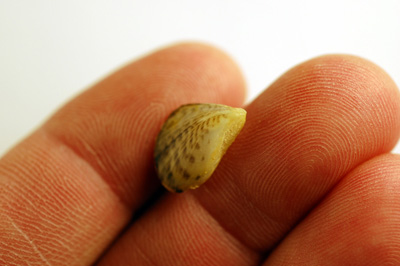 |
Quagga mussels range in size from microscopic to 1.5 inches (Photo courtesy of David Britton, U.S. Fish and Wildlife Service and the 100th Meridian Initiative). |
The invasive quagga mussel, which has been responsible for causing economical and ecological damage in all of the five Great Lakes, was discovered for the first time west of the Rocky Mountains in January 2007, in the Lake Mead National Recreation Area.
Quagga mussels are now distributed in the Great Lakes region throughout several inland water bodies in bordering states including New York, Ohio, Michigan and Pennsylvania. Cayuga Lake, Onondaga Lake and Seneca Lake in New York are just a few of the water systems seeing the mussel in the Northeast. The St. Lawrence River has even spread the mussels north as far as Ontario and Quebec.
“Before, quagga mussels were unknown inside this country except in the Great Lakes,” John Wullschleger, Colorado fishery biologist for the National Park Service, said.
Quagga mussels are filter feeders that attach to firm surfaces such as rocks, mud and the sides of boats. Boats and boating equipment are the perfect tools of transportation for these mussels. The microscopic larvae, also known as veligers, float around on water and are easily transported downstream.
“Even if the mussels have been exposed to air, if there are certain areas that are moist, they can survive,” Wullschleger said.
| Recreational boaters enjoy the scenic mountain views of Lake Mead (Photo courtesy of National Park Service). |
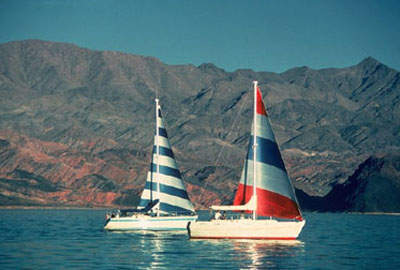 |
They feed on phytoplankton, affecting the ecology and food web of the lake. Taking this link out of the food chain can have serious consequences.
“We fear a collapse of the ecosystem from the bottom down,” David Britton, assistant aquatic invasive species coordinator for the Southwest Region’s Division of Fisheries and Habitat Conservation of Arlington, Texas, said.
It is not only the aquatic life that is in jeopardy. Lake Mead is responsible for supplying drinking water to millions in the Southwest.
“Our issue is that we have a responsibility to provide clean water to two million people,” Roger Buehrer, spokesperson for Southern Nevada water authority, said, “We will do what it takes to provide that service.”
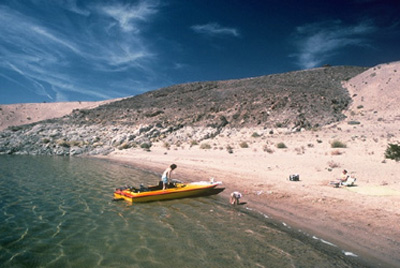 |
A recreational boater seeks refuge on the clear, sandy shores of Lake Mead (Photo courtesy of National Park Service). |
Quagga mussels pile on top of one another building up a layer so thick that could eventually clog pipes, affecting the efficiency of the water intake.
“I think that probably the biggest cost is probably going to be if they start to plug water systems,” Wullschleger said.
Chlorination has proven to be a very effective tool in quagga mussel control, but it hasn’t come without a cost.
“We are spending about $2,000 a day on quagga control,” Buehrer said.
Unfortunately, these are all costs that will only be passed down to the consumer. Electricity and drinking water rates will increase. In addition, the byproducts of chlorine are unhealthy for consumers.
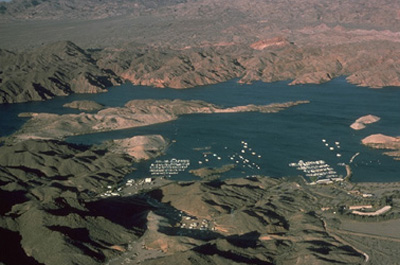 |
Lake Mead’s shoreline is 110 miles, making it the largest man-made lake in the United States (Photo courtesy of National Park Service). |
“It requires a lot of chlorine and that ends up in our water,” Britton said.
Lake Mead is a popular vacation area of leisure and recreation that receives about eight million visitors per year.
“A third concern relates to the impact for recreation,” Kent Turner, chief of Resource Management at Lake Mead, said.
The mussels clog up the water intakes going into the boats and cause visitors’ boats to stop working.
“I have already noticed that people called and complained,” Britton said.
|
Quagga mussels were found attached to an underwater rock in Lake Mead (Photo courtesy of David Kushner, 100th Meridian Initiative). |
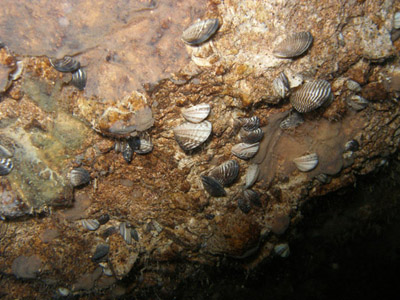 |
The mussels will eventually start to die off and show up all over the beach producing a foul odor.
“People don’t want to smell that or have their feet cut,” Britton said.
Turner is concerned that Lake Mead will also become less appealing due to recent rules and regulations put in place. Turner is concerned that visitors will not want to deal with routine boat checks for quagga mussels.
“Any boat that has been in a marina or water for an amount of time, we require to be inspected and cleaned before it leaves,” Turner said.
There is a conflict between wanting to stop the spread of mussels and allowing boaters their freedom.
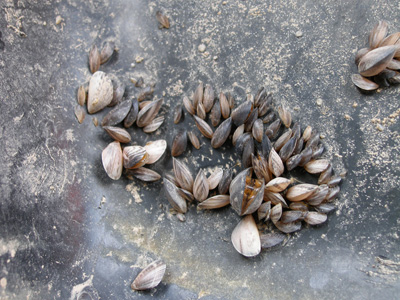 |
Quagga mussels are filter feeders that form dense colonies and cause severe ecological damage (Photo courtesy of David Britton, U.S. Fish and Wildlife Service and the 100th Meridian Initiative). |
“We don’t want to impact recreation with policing, but we want to keep the waters safe,” Britton said.
Turner believes that educating boaters is one of the best ways to stop the spread of the quagga mussels. There is everything from hand-outs to enhanced boating educational programs.
“Individual boat owners have to take responsibility,” Turner said, “The way they can be reached is through education.”
Prevention is key when it comes to dealing with the quagga mussels.
“I don’t think there is an easy way of getting rid of these things,” Wullschleger said.
The only water body where they have ever been eradicated was at Millbrook Quarry in Virginia. This water body has no incoming or outgoing water traffic, so they were able to eliminate the species with potassium chloride.
|
Quagga mussels can attach themselves to anything (Photo courtesy of David Britton, U.S. Fish and Wildlife Service and the 100th Meridian Initiative). |
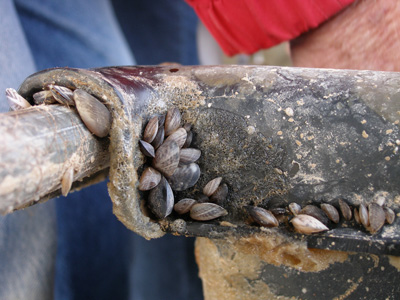 |
“Can you really treat a mussel population that’s on a resort that’s 100 miles long?” Wullschleger asked.
After their introduction to Lake Mead, the mussels have traveled downstream and are now scattered throughout the Colorado River system. At this point, there is no feasible eradication method for a body of water this large.
“For now it is mostly about management and working with others for prevention and monitoring,” Turner said.
Turner believes that public education is the key and it can be a success.
“Convincing people that the problem is real,” Britton said, “That’s the biggest challenge.”

Comments are Closed